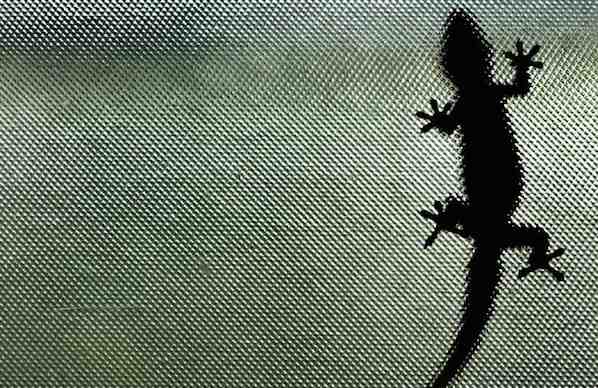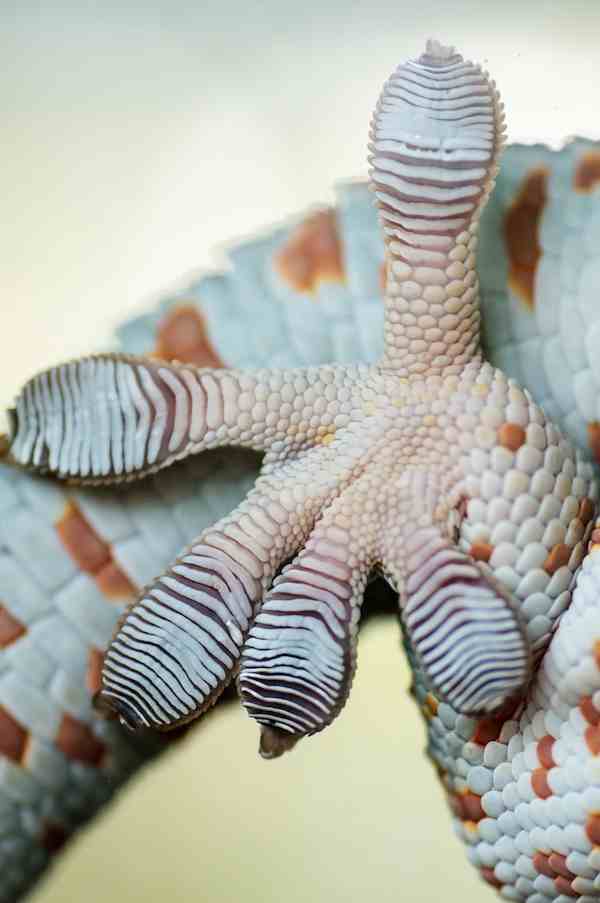
[Image above] A gecko clings to a glass window, thanks to its unique toe pad nanostructures. Credit: Steve Evans; Wikimedia CC BY 2.0
Nature inspires intelligently designed materials—what better place to look for inspiration than what’s evolved over millions of years? All that time has led to some pretty interesting adaptations in the creatures that inhabit the earth. Some are weird, some are wacky, and some are just plain wonderful.
These adaptations have been great inspiration for new innovation in materials.
When it comes to strength, structures like bone and nacre (here and here) are excellent examples of how nature does it better.
When it comes to surface nanostructures, lotus leaves and Namibian desert beetles reign supreme.

Rows of lamellae further branch into lots and lots of teeny-tiny setae on each gecko toe. Credit: Rob Osborne; Flickr CC BY-NC-ND 2.0
And when it comes to adhesion, gecko feet hold the gold standard.
Geckos—and some other lizards, like anoles—have toes that are equipped with thousands of little spatula-shaped structures, called setae. The setae look like microscopic hairs, but because only mammals have hair, they’re actually tiny adaptations of the geckos’ skin. Most are only about 100 μm long (equivalent to the width of a human hair) and are much, much thinner in width. The setae provide their little feet with remarkable surface area to be able to stick any landing.
Not all geckos have sticky feet though—some have adapted to environments that don’t require them to climb, scale, and scurry upwards. Leopard geckos, for example, are desert-dwelling creatures. My pet leopard gecko, Zeke, however, doesn’t yet know of his handicap, and I don’t have the heart to tell him that he’s not like the other geckos. I often find him standing up on his back legs against the glass of his aquarium abode, furiously flailing his front limbs in an attempt at scaling the wall. He is not successful.
Nonetheless, the remarkable stickiness of (most) gecko feet has provided inspiration for a host of biomaterials, including novel “geckel” adhesives and self-cleaning surfaces. DARPA even has a project aimed at allowing people to scale walls in true gecko fashion.
Watch this video to hear more gecko science, see some geckos in action, and discover one way they’re inspiring smarter spidey-like materials.
Credit: cplai; YouTube
But the whole reason behind why gecko feet are so sticky has recently been called to question with a paper published in the Journal of the Royal Society Interface.
While it was long believed that weak molecular van der Waals forces “indisputably” explain the stick between gecko toes and a smooth surface—and, interestingly, help hold asteroids together—the new research suggests that electrostatic forces shouldn’t be underestimated, too.
The prevailing thought, for many decades, was that van der Waals forces allowed those hairs to keep contact with a surface. But that thought was largely because of an experiment back in the 1930s that ruled out electrostatic forces, according to a Science News article. However, that could be due to experimental limitations at that time, the lead author of the new study says.
The new study looked at how tokay geckos stick to two different surfaces—Teflon AF vs. silicone rubber polydimethylsiloxane. The scientists picked these surfaces because they have similar van der Waals interactions with gecko toes. If van der Waals interactions were solely responsible for sticking to these surfaces, then, they postulated, the geckos should adhere equally well to each.
But, gecko setae stuck to Teflon AF about twice as strong as to the silicone, suggesting there’s more than just van der Waals working between the materials. Measuring electrostatic charges between the toes and surfaces showed that they were interacting with one another.
(What’s really fascinating about this study is that they used tokay geckos—which are notoriously aggressive. I hope no poor researchers lost fingertips in the experiments!)
Not all researchers are ready to dismiss van der Waals forces, according to the Science News article. Instead, it’s possible that both are important for the geckos’ sticky feet, and perhaps each could be more important in different situations.
The paper is “Role of contact electrification and electrostatic interactions in gecko adhesion” (DOI: 10.1098/rsif.2014.0371).
No matter what scientific prinicples describe how they stick, the fact is that geckos are really good at sticking to surfaces. So, how exactly do they “unstick” those little toes when they want to move?
Researchers at Oregon State University have been busy using applied physics to investigate that question.
“Understanding the subtleties of the process for switching stickiness on and off is groundbreaking,” author and engineering professor Alex Greaney says in an American Institute of Physics press release. “By using mathematical modeling, we’ve found a simple, but ingenious, mechanism allows the gecko to switch back and forth between being sticky or not. Geckos’ feet are by default nonsticky, and this stickiness is activated through application of a small shear force. Gecko adhesion can be thought of as the opposite of friction.”
Although the paper, published in the Journal of Applied Physics, is pretty heavy on the physics, the basic point is that gecko toes can unstick and stick easily because their setae are set at oblique angles, rather than being straight (see that SEM image up there). When geckos drag their feet, they can change the contact angles of those setae and stick/unstick at will, with no loss of energy and thus minimal effort.
The work may unlock some of the secrets needed to design better materials, as the abstract states, “In this model, obliquely canted seta (as possessed by geckos) rather than vertically aligned fibers (common in synthetic dry adhesive) provides the most robust adhesion.”
That paper is “Role of seta angle and flexibility in the gecko adhesion mechanism” (DOI: 10.1063/1.4892628).
Despite all the knowledge about how geckos do it, it remains really hard to duplicate their sticky structures. So, rather than re-engineering what the gecko has already accomplished, some other researchers are taking a different approach by using the geckos’ feet themselves.
Using an X-acto knife, a team of researchers in South Korea sliced off geckos’ toe pads—a process that they say doesn’t harm the gecko because they regenerate their pads with each skin molt—and used them as a tiny stamp.
They pulled out the superglue, stuck the pads to a piece of glass, and began a process they’ve dubbed “geckoprinting.”
“Then they were able to pick up, move, and detach small pieces of silicon and attach them to other surfaces,” says a Popular Mechanics article. “When they dragged the stamp in the opposite direction, they could disengage it. They gecko-printed silicon wafers onto other silicon wafers, onto the leaf of a leopard plant, and onto the wings and body of a darkling beetle.”
The authors speculate a similar stamp could be used to move small, fragile silicon chips for mini-electronics, or to manipulate other tiny and delicate structures or objects. And while it likely won’t work well for large-scale manufacturing, it may be able to inspire some similar but simpler designs that could be scaled for certain tasks.
The paper, published in the Journal of the Royal Society Interface, is “Geckoprinting: assembly of microelectronic devices on unconventional surfaces by transfer printing with isolated gecko setal arrays” (DOI: 10.1098/rsif.2014.0627).

